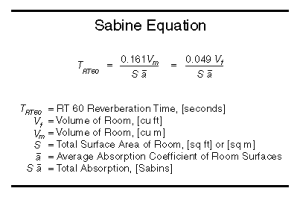Sabine Formula for Reverberation Time
Sabine equation
Sabine’s reverberation equation was developed in the late 1890s in an empirical fashion. He established a relationship between the RT60 of a room, its volume, and its total absorption (in sabins). This is given by the equation:
 .
.
where  is the speed of sound in the room (for 20 degrees Celsius),
is the speed of sound in the room (for 20 degrees Celsius),  is the volume of the room in m³,
is the volume of the room in m³,  total surface area of room in m²,
total surface area of room in m²,  is the average absorption coefficient of room surfaces, and the product
is the average absorption coefficient of room surfaces, and the product  is the total absorption in sabins.
is the total absorption in sabins.
The total absorption in sabins (and hence reverberation time) generally changes depending on frequency (which is defined by the acoustic properties of the space). The equation does not take into account room shape or losses from the sound travelling through the air (important in larger spaces). Most rooms absorb less sound energy in the lower frequency ranges resulting in longer reverb times at lower frequencies.
Sabine concluded that the reverberation time depends upon the reflectivity of sound from various surfaces available inside the hall. If the reflection is coherent, the reverberation time of the hall will be longer; the sound will take more time to die out.
The reverberation time RT60 and the volume V of the room have great influence on the critical distance dc (conditional equation):
where critical distance  is measured in meters, volume
is measured in meters, volume  is measured in m³, and reverberation time
is measured in m³, and reverberation time  is measured in seconds.
is measured in seconds.

Measurement of reverberation time[edit]
Historically reverberation time could only be measured using a level recorder (a plotting device which graphs the noise level against time on a ribbon of moving paper). A loud noise is produced, and as the sound dies away the trace on the level recorder will show a distinct slope. Analysis of this slope reveals the measured reverberation time. Some modern digitalsound level meters can carry out this analysis automatically.
Several methods exist for measuring reverb time. An impulse can be measured by creating a sufficiently loud noise (which must have a defined cut off point). Impulse noise sources such as a blank pistol shot or balloon burst may be used to measure the impulse response of a room.
Alternatively, a random noise signal such as pink noise or white noise may be generated through a loudspeaker, and then turned off. This is known as the interrupted method, and the measured result is known as the interrupted response.
A two port measurement system can also be used to measure noise introduced into a space and compare it to what is subsequently measured in the space. Consider sound reproduced by a loudspeaker into a room. A recording of the sound in the room can be made and compared to what was sent to the loudspeaker. The two signals can be compared mathematically. This two port measurement system utilizes a Fourier transform to mathematically derive the impulse response of the room. From the impulse response, the reverberation time can be calculated. Using a two port system allows reverberation time to be measured with signals other than loud impulses. Music or recordings of other sound can be used. This allows measurements to be taken in a room after the audience is present.
Reverberation time is usually stated as a decay time and is measured in seconds. There may or may not be any statement of the frequency band used in the measurement. Decay time is the time it takes the signal to diminish 60 dB below the original sound.
The concept of Reverberation Time implicitly supposes that the decay rate of the sound is exponential, so that the sound level diminishes regularly, at a rate of so many dB per second. It is not often the case in real rooms, depending on the disposition of reflective, dispersive and absorbing surfaces. Moreover, successive measurement of the sound level often yields very different results, as differences in phase in the exciting sound build up in notably different sound waves. In 1965,Manfred R. Schroeder published “A new method of Measuring Reverberation Time” in the Journal of the Acoustical Society of America. He proposed to measure, not the power of the sound, but the energy, by integrating it. This made it possible to show the variation in the rate of decay, and to free acousticians from the necessity of averaging many measurements.


